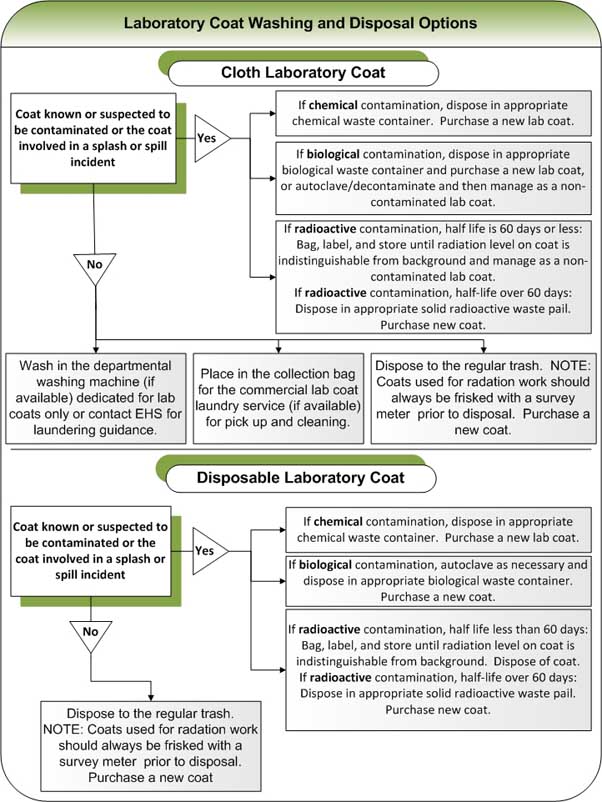Laboratory Coat Information
There are a number of types of lab coats, which provide varying degrees of protection. A few examples of the different protection available include splash resistant coats, static free coats,
chemical resistant coats and flame resistant coats. Please make sure that the coat you are selecting provides the type of protection that is appropriate for your needs.
Lab coats and other protective wear used in a lab should be kept in the work area to minimize the possibility of spreading chemicals to public places including eating or office areas.
Properties of Protective Clothing Materials
| Materials |
Strength |
Chemical Resistance |
Flammability |
Static Properties |
Comfort |
Uses |
| Butyl and Neoprene |
Usually reinforced at points of strain; will not stick together, peel, crack, or stiffen |
Resistant to solvents and corrosive chemicals |
Can be ignited by a direct flame or by flammable materials in the presence of an ignition source. |
Could accumulate a static charge |
Lightweight |
Aprons, sleeve protectors, boot covers |
| Cotton |
Moderate durability |
Limited incidental splash protection |
Can ignite by direct flame or by flammable materials in presence of an ignition source. Flame retardant treatment is available. |
Could accumulate a static charge |
Comfortable, lightweight |
Lab Coats |
| Modacrylic |
Resistant to rips and tears but less so than polyamide fibers; abrasion-resistant but less so than nylon or polyester |
Resistant to many chemicals |
Can be ignited by a direct flame or by flammable materials in the presence of an ignition source. |
Has antistatic properties |
Comfortable, soft, and resilient; easy to clean; has soil release properties |
Lab Coats |
| Nomex |
Exceptionally strong and abrasion resistant |
Limited incidental splash protection |
Fire Resistant |
Has antistatic properties |
Comfortable, breathable |
Lab coats, aprons and sleeve protectors |
| Nylon |
Exceptionally strong and abrasion resistant |
Limited incidental splash protection |
Can be ignited by a direct flame or by flammable materials in the presence of an ignition source. |
Static buildup possible; requires antistatic agent |
Lightweight |
Lab Coats |
| Polypropylene |
Strong |
Resistant to many chemicals |
Can be ignited by a direct flame or by flammable materials in the presence of an ignition source. |
Static buildup; requires antistatic agent |
Lightweight |
Aprons |
| Rayon |
Fairly Durable |
Limited incidental splash protection |
Can be ignited by a direct flame or by flammable materials in the presence of an ignition source. |
Degraded by acids; binds some chemicals |
|
Lab Coats |
| Silver Shield (4H) |
Strong, repeated abrasions will rip and tear the material |
Resistant to many chemicals |
Can be ignited by a direct flame or by flammable materials in the presence of an ignition source. |
Has antistatic properties |
Lightweight |
Aprons, sleeve protectors, boot covers |
NOTE: Contact the individual lab coat or chemical protective equipment manufacturers for specific chemical, fire and antistatic protection data and information. Do not exclusively rely on the
information in this chart.
Select lab coat/apron using the following recommendations:
- Length - At least knee length or longer is recommended for most effective coverage.
- Wristband - It is recommended that a lab coat with a fitted wristband/cuff be used to reduce the potential for splashes up the arm and fire hazards.
- Top button - It is best to use a lab coat that provides for a high top button at the neck to provide most effective protection.
- Fire resistant - Use only those constructed of a flame resistant material.
There are three options for cleaning laboratory coats:
- Clean in departmental washer/dryer system dedicated for laboratory coat washing. Whether contaminated or not, cloth laboratory coats should not be taken to the home or to a public
laundromat for washing. Contact EHS for recommendations and special procedures if you wish to launder your lab coats at home or at a public laundromat.
- Service provided by department for lab coat cleaning.
- Dispose of lab coat.

Any questions or concerns related to laboratory coat information should be addressed to the Chemical Hygiene Officer at dehsafety@udel.edu or call 302-831-8475.
More Information



